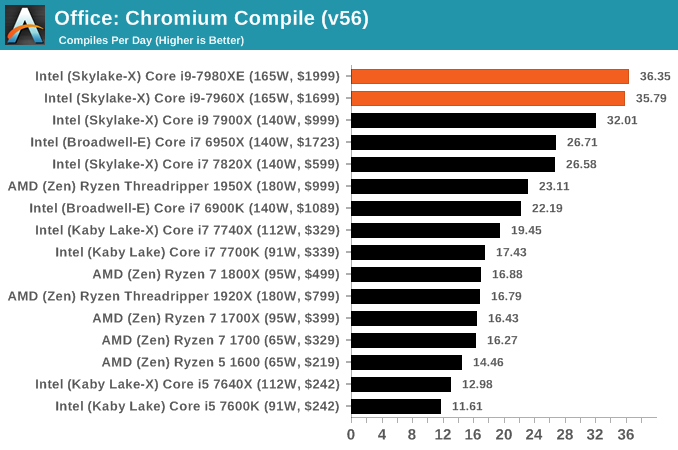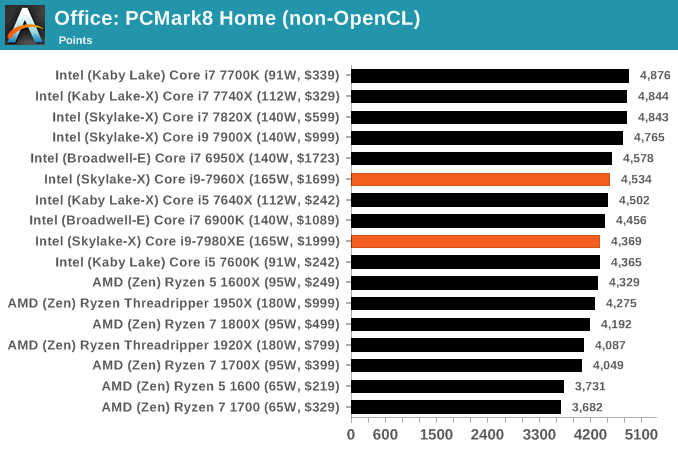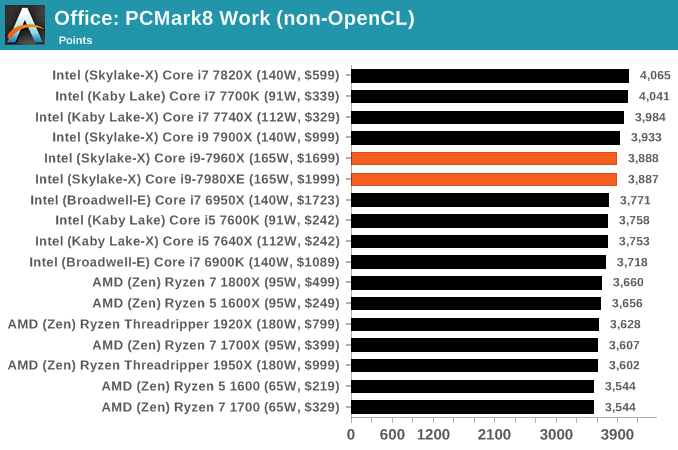The Intel Core i9-7980XE and Core i9-7960X CPU Review Part 1: Workstation
by Ian Cutress on September 25, 2017 3:01 AM ESTBenchmarking Performance: CPU Office Tests
The office programs we use for benchmarking aren't specific programs per-se, but industry standard tests that hold weight with professionals. The goal of these tests is to use an array of software and techniques that a typical office user might encounter, such as video conferencing, document editing, architectural modelling, and so on and so forth.
All of our benchmark results can also be found in our benchmark engine, Bench.
Chromium Compile (v56)
Our new compilation test uses Windows 10 Pro, VS Community 2015.3 with the Win10 SDK to combile a nightly build of Chromium. We've fixed the test for a build in late March 2017, and we run a fresh full compile in our test. Compilation is the typical example given of a variable threaded workload - some of the compile and linking is linear, whereas other parts are multithreaded.

PCMark8: link
Despite originally coming out in 2008/2009, Futuremark has maintained PCMark8 to remain relevant in 2017. On the scale of complicated tasks, PCMark focuses more on the low-to-mid range of professional workloads, making it a good indicator for what people consider 'office' work. We run the benchmark from the commandline in 'conventional' mode, meaning C++ over OpenCL, to remove the graphics card from the equation and focus purely on the CPU. PCMark8 offers Home, Work and Creative workloads, with some software tests shared and others unique to each benchmark set.












152 Comments
View All Comments
mapesdhs - Tuesday, September 26, 2017 - link
In that case, using Intel's MO, TR would have 68. What Intel is doing here is very misleading.iwod - Monday, September 25, 2017 - link
If we factor in the price of the whole system, rather then just CPU, ( AMD's MB tends to be cheaper ), then AMD is doing pretty well here. I am looking forward to next years 12nm Zen+.peevee - Monday, September 25, 2017 - link
From the whole line, only 7820X makes sense from price/performance standpoint.boogerlad - Monday, September 25, 2017 - link
Can an IPC comparison be done between this and Skylake-s? Skylake-x LCC lost in some cases to skylake, but is it due to lack of l3 cache or is it because the l3 cache is slower?IGTrading - Monday, September 25, 2017 - link
There will never be an IPC comparison of Intel's new processors, because all it would do is showcase how Intel's IPC actually went down from Broadwell and further down from KabyLake.Intel's IPC is a downtrend affair and this is not really good for click and internet traffic.
Even worse : it would probably upset Intel's PR and that website will surely not be receiving any early review samples.
rocky12345 - Monday, September 25, 2017 - link
Great review thank you. This is how a proper review is done. Those benchmarks we seen of the 18 core i9 last week were a complete joke since the guy had the chip over clocked to 4.2GHz on all core which really inflated the scores vs a stock Threadripper 16/32 CPU. Which was very unrealistic from a cooling stand point for the end users.This review had stock for stock and we got to see how both CPU camps performed out of the box states. I was a bit surprised the mighty 18 core CPU did not win more of the benches and when it did it was not by very much most of the time. So a 1K CPU vs a 2K CPU and the mighty 18 core did not perform like it was worth 1K more than the AMD 1950x or the 1920x for that matter. Yes the mighty i9 was a bit faster but not $1000 more faster that is for sure.
Notmyusualid - Thursday, September 28, 2017 - link
I too am interested to see 'out of the box performance' also.But if you think ANYONE would buy this and not overclock - you'd have to be out of your mind.
There are people out there running 4.5GHz on all cores, if you look for it.
And what is with all this 'unrealistic cooling' I keep hearing about? You fit the cooling that fits your CPU. My 14C/28T CPU runs 162W 24/7 running BOINC, and is attached to a 480mm 4-fan all copper radiator, and hand on my heart, I don't think has ever exceeded 42C, and sits at 38C mostly.
If I had this 7980XE, all I'd have to do is increase pump speed I expect.
wiyosaya - Monday, September 25, 2017 - link
Personally, I think the comments about people that spend $10K on licenses having the money to go for the $2K part are not necessarily correct. Companies will spend that much on a license because they really do not have any other options. The high end Intel part in some benchmarks gets 30 to may be 50 percent more performance on a select few benchmarks. I am not going to debate that that kind of performance improvement is significant even though it is limited to a few benchmarks; however, to me that kind of increased performance comes at an extreme price premium, and companies that do their research on the capabilities of each platform vs price are not, IMO, likely to throw away money on a part just for bragging rights. IMO, a better place to spend that extra money would be on RAM.HStewart - Monday, September 25, 2017 - link
In my last job, they spent over $100k for software version system.In workstation/server world they are looking for reliability, this typically means Xeon.
Gaming computers are different, usually kids want them and have less money, also they are always need to latest and greatest and not caring about reliability - new Graphics card comes out they replace it. AMD is focusing on that market - which includes Xbox One and PS 4
For me I looking for something I depend on it and know it will be around for a while. Not something that slap multiple dies together to claim their bragging rights for more core.
Competition is good, because it keeps Intel on it feat, I think if AMD did not purchase ATI they would be no competition for Intel at all in x86 market. But it not smart also - would anybody be serious about placing AMD Graphics Card on Intel CPU.
wolfemane - Tuesday, September 26, 2017 - link
Hate to burst your foreign bubble but companies are cheap in terms of staying within budgets. Specially up and coming corporations. I'll use the company I work for as an example. Fairly large print shop with 5 locations along the US West coast that's been in existence since the early 70's. About 400 employees in total. Server, pcs, and general hardware only sees an upgrade cycle once every 8 years (not all at once, it's spread out). Computer hardware is a big deal in this industry, and the head of IT for my company Has done pretty well with this kind of hardware life cycle. First off, macs rule here for preprocessing, we will never see a Windows based pc for anything more than accessing the Internet . But when it comes to our servers, it's running some very old xeons.As soon as the new fiscal year starts, we are moving to an epyc based server farm. They've already set up and established their offsite client side servers with epyc servers and IT absolutely loves them.
But why did I bring up macs? The company has a set budget for IT and this and the next fiscal year had budget for company wide upgrades. By saving money on the back end we were able to purchase top end graphic stations for all 5 locations (something like 30 new machines). Something they wouldn't have been able to do to get the same layout with Intel. We are very much looking forward to our new servers next year.
I'd say AMD is doing more than keeping Intel on their feet, Intel got a swift kick in the a$$ this year and are scrambling.